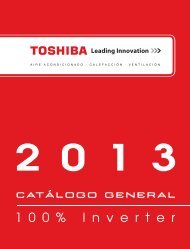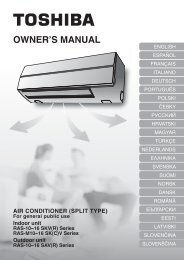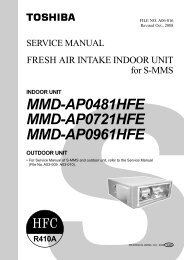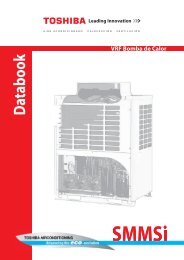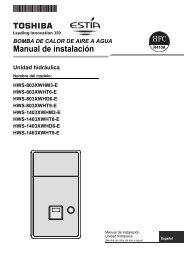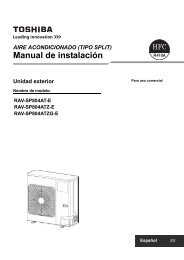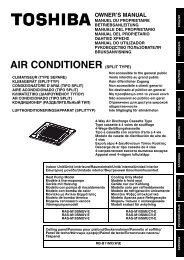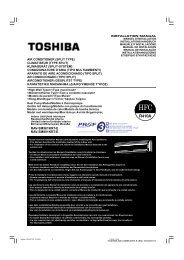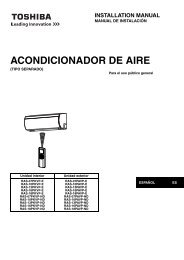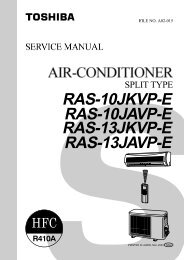SERVICE MANUAL - Alarko Carrier
SERVICE MANUAL - Alarko Carrier
SERVICE MANUAL - Alarko Carrier
You also want an ePaper? Increase the reach of your titles
YUMPU automatically turns print PDFs into web optimized ePapers that Google loves.
2. Characteristics required for flux<br />
• Activated temperature of flux coincides with the<br />
brazing temperature.<br />
• Due to a wide effective temperature range, flux<br />
is hard to carbonize.<br />
• It is easy to remove slag after brazing.<br />
• The corrosive action to the treated metal and<br />
brazing filler is minimum.<br />
• It excels in coating performance and is harmless<br />
to the human body.<br />
As the flux works in a complicated manner as<br />
described above, it is necessary to select an<br />
adequate type of flux according to the type and<br />
shape of treated metal, type of brazing filler and<br />
brazing method, etc.<br />
3. Types of flux<br />
• Noncorrosive flux<br />
Generally, it is a compound of borax and boric<br />
acid.<br />
It is effective in case where the brazing temperature<br />
is higher than 800°C.<br />
• Activated flux<br />
Most of fluxes generally used for silver brazing<br />
are this type.<br />
It features an increased oxide film removing<br />
capability due to the addition of compounds<br />
such as potassium fluoride, potassium chloride<br />
and sodium fluoride to the borax-boric acid<br />
compound.<br />
4. Piping materials for brazing and used<br />
brazing filler/flux<br />
3-5-3. Brazing<br />
As brazing work requires sophisticated techniques,<br />
experiences based upon a theoretical knowledge, it<br />
must be performed by a person qualified.<br />
In order to prevent the oxide film from occurring in<br />
the pipe interior during brazing, it is effective to<br />
proceed with brazing while letting dry Nitrogen gas<br />
(N2) flow.<br />
Never use gas other than Nitrogen gas.<br />
1. Brazing method to prevent oxidation<br />
1) Attach a reducing valve and a flow-meter to<br />
the Nitrogen gas cylinder.<br />
2) Use a copper pipe to direct the piping material,<br />
and attach a flow-meter to the cylinder.<br />
3) Apply a seal onto the clearance between the<br />
piping material and inserted copper pipe for<br />
Nitrogen in order to prevent backflow of the<br />
Nitrogen gas.<br />
4) When the Nitrogen gas is flowing, be sure to<br />
keep the piping end open.<br />
5) Adjust the flow rate of Nitrogen gas so that it<br />
is lower than 0.05 m 3 /Hr or 0.02 MPa<br />
(0.2kgf/cm 2 ) by means of the reducing valve.<br />
6) After performing the steps above, keep the<br />
Nitrogen gas flowing until the pipe cools down<br />
to a certain extent (temperature at which<br />
pipes are touchable with hands).<br />
7) Remove the flux completely after brazing.<br />
Piping material<br />
Used brazing filler<br />
Used flux<br />
Copper - Copper<br />
Copper - Iron<br />
Phosphor copper<br />
Silver<br />
Do not use<br />
Paste flux<br />
M<br />
Flow meter<br />
Iron - Iron<br />
Silver<br />
Vapor flux<br />
Stop valve<br />
1. Do not enter flux into the refrigeration cycle.<br />
2. When chlorine contained in the flux remains<br />
within the pipe, the lubricating oil deteriorates.<br />
Therefore, use a flux which does not contain<br />
chlorine.<br />
3. When adding water to the flux, use water<br />
which does not contain chlorine (e.g. distilled<br />
water or ion-exchange water).<br />
4. Remove the flux after brazing.<br />
Nitrogen gas<br />
cylinder<br />
Pipe<br />
From Nitrogen cylinder<br />
Rubber plug<br />
Nitrogen<br />
gas<br />
Fig. 3-5-1 Prevention of oxidation during brazing<br />
– 31 –



